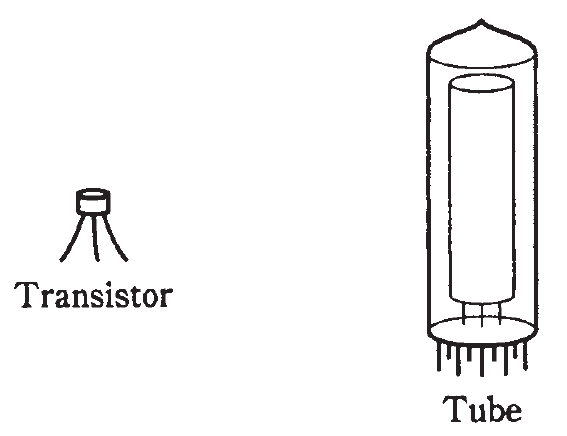


 الفيزياء الكلاسيكية
الفيزياء الكلاسيكية
 الكهربائية والمغناطيسية
الكهربائية والمغناطيسية
 علم البصريات
علم البصريات
 الفيزياء الحديثة
الفيزياء الحديثة
 النظرية النسبية
النظرية النسبية
 الفيزياء النووية
الفيزياء النووية
 فيزياء الحالة الصلبة
فيزياء الحالة الصلبة
 الليزر
الليزر
 علم الفلك
علم الفلك
 المجموعة الشمسية
المجموعة الشمسية
 الطاقة البديلة
الطاقة البديلة
 الفيزياء والعلوم الأخرى
الفيزياء والعلوم الأخرى
 مواضيع عامة في الفيزياء
مواضيع عامة في الفيزياء|
Read More
Date: 29-4-2021
Date: 13-5-2021
Date: 11-4-2021
|
The semiconductor revolution
It wasn’t too long ago that vacuum tubes were the backbone of electronic equipment. Even in radio receivers and “portable” television sets, all of the amplifiers, oscillators, detectors, and other circuits required these devices. A typical vacuum tube ranged from the size of your thumb to the size of your fist.
A radio might sit on a table in the living room; if you wanted to listen to it, you would turn it on and wait for the tube filaments to warm up. I can remember this. It makes me feel like an old man to think about it.
Vacuum tubes, sometimes called “tubes” or “valves” (in England), are still used in some power amplifiers, microwave oscillators, and video display units. There are a few places where tubes work better than semiconductor devices. Tubes tolerate momentary voltage and current surges better than semiconductors. Tubes need rather high voltages to work. Even in radio receivers, turntables, and other consumer devices, 100 V to 200 V dc was required when tubes were employed. This mandated bulky power supplies and created an electrical shock hazard.
Nowadays, a transistor about the size of a pencil eraser can perform the functions of a tube in most situations. Often, the power supply can be a couple of AA cells or a 9-V “transistor battery.”
Figure 1 is a size comparison drawing between a typical transistor and a typical vacuum tube.

Figure 1: Transistors are smaller than tubes.
Integrated circuits, hardly larger than individual transistors, can do the work of hundreds or even thousands of vacuum tubes. An excellent example of this technology is found in the personal computer, or PC. In 1950, a “PC” would have occupied a large building, required thousands of watts to operate, and probably cost well over a million dollars. Today you can buy one and carry it in a briefcase.



|
|
|
|
دراسة يابانية لتقليل مخاطر أمراض المواليد منخفضي الوزن
|
|
|
|
|
|
|
اكتشاف أكبر مرجان في العالم قبالة سواحل جزر سليمان
|
|
|
|
|
|
|
اتحاد كليات الطب الملكية البريطانية يشيد بالمستوى العلمي لطلبة جامعة العميد وبيئتها التعليمية
|
|
|